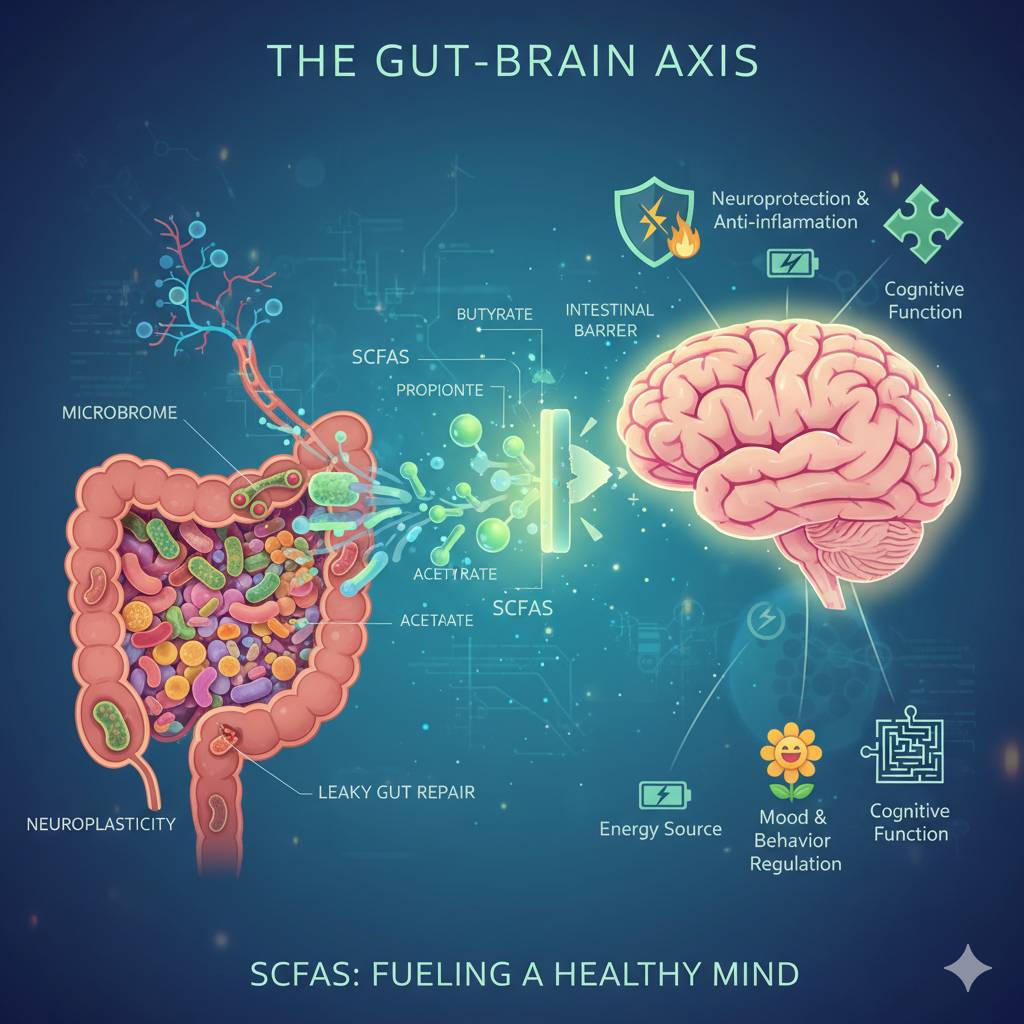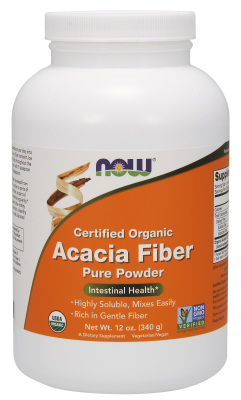Yes, Short-Chain Fatty Acids (SCFAs) produced by “good” gut bacteria are widely believed to be beneficial for brain health and function.
They are key mediators in the gut-brain axis, the complex communication network between your gut and your brain.
Here’s a breakdown of their potential benefits and mechanisms:
- 🧠 Neuroprotection and Anti-inflammation: SCFAs, particularly butyrate, have anti-inflammatory properties. This is important because chronic neuroinflammation is implicated in many neurological and psychiatric disorders. Butyrate can also help maintain the integrity of the blood-brain barrier (BBB), which is crucial for protecting the brain from harmful substances.
- ⚡ Energy Source: SCFAs, especially acetate, can cross the blood-brain barrier and may serve as an energy source for brain cells, helping to regulate energy balance. Butyrate can also increase the production of ketone bodies, which are an alternative fuel source for the brain.
- 😊 Mood and Behavior Regulation: SCFAs can modulate the levels of neurotransmitters (like serotonin) and neurotrophic factors (like Brain-Derived Neurotrophic Factor or BDNF), which are essential for neuronal growth, survival, and mood regulation. Low levels of SCFA-producing bacteria have been observed in conditions like depression.
- 🧠 Cognitive Function: Studies suggest that SCFAs may improve cognitive function, potentially by mitigating age-related cognitive decline and improving recovery after conditions like stroke.
- 🛡️ Gut Barrier Function: SCFAs are the primary energy source for the cells lining your colon. By strengthening the gut barrier, they help prevent “leaky gut,” which can reduce the transfer of inflammatory signals and toxins from the gut to the brain.
In summary, SCFAs act as crucial messengers that link a healthy gut microbiome to a healthy brain by reducing inflammation, supplying energy, and influencing the chemical environment of the central nervous system.
Which foods can help increase your SCFA production?
The best way to increase your Short-Chain Fatty Acids (SCFAs) is by consuming prebiotic foods, which are specific types of dietary fiber that your beneficial gut bacteria love to ferment.
Here are the key foods and food components that boost SCFA production:
🥕 Top SCFA-Boosting Foods
| Food Category | Key Examples | Primary SCFA Benefit |
| Resistant Starch | Green (unripe) bananas, oats, potatoes/rice/pasta that have been cooked and then cooled (retrograded starch) | Feeds bacteria deeper in the colon, strongly promotes Butyrate production, which is key for colon health and the gut-brain axis. |
| Alliums (Inulin) | Garlic, onions, leeks, shallots, chicory root | Rich in inulin and fructans, which are potent prebiotics that boost overall SCFA and Bifidobacteria growth. |
| Legumes & Beans | Lentils, black beans, chickpeas, kidney beans | Excellent source of both soluble fiber and resistant starch, providing a long-lasting fuel source for SCFA producers. |
| Whole Grains | Oats (especially raw/rolled), barley, rye, whole wheat, brown rice | High in beta-glucans and other soluble fibers that are easily fermented. |
| Fruits | Apples (with peel), berries, pears, slightly under-ripe bananas | Contain pectin (a type of soluble fiber) and polyphenols (plant compounds that act as prebiotics). |
| Nuts & Seeds | Chia seeds, flaxseeds, almonds, walnuts | High in soluble fiber and healthy fats; ground flaxseed is particularly effective. |
| Root Vegetables | Jerusalem artichokes, asparagus, sweet potatoes, carrots | Great sources of inulin and other prebiotic fibers. |
🌟 Key Component: Resistant Starch
Resistant Starch (RS) is one of the most powerful boosters of the beneficial SCFA butyrate. It gets its name because it resists digestion in the small intestine and arrives intact in the colon to feed the SCFA-producing bacteria.
How to get more Resistant Starch:
- Cook and Cool Starches: When you cook and then refrigerate starchy foods like rice, potatoes, or pasta for at least 12 hours, the structure of the starch changes, creating Resistant Starch (RS3). Reheating them doesn’t eliminate all of the RS, so you can still eat them warm.
- Use Potato Starch: A small amount (1-2 tablespoons) of raw potato starch stirred into a cold drink is a highly concentrated source of resistant starch.
Important Note: If you are new to eating high-fiber or prebiotic foods, introduce them slowly to avoid digestive discomfort (gas and bloating). Increasing your water intake at the same time can also help.
Lets explore which specific SCFA (like Butyrate or Acetate) is associated with a particular brain health benefit?
The three main SCFAs—Butyrate, Propionate, and Acetate—each have a slightly different area of impact, even though they all contribute to overall brain health.
Here is a breakdown of the specific roles each major SCFA plays in the brain and nervous system:
🔬 SCFA Breakdown: Roles in Brain Health
1. Butyrate (The Neuro-Protector & Mood Booster)
Butyrate is arguably the most well-studied SCFA for its direct impact on brain and mental health.
| Area of Impact | Specific Benefit/Mechanism |
| Neuroinflammation | Reduces Neuroinflammation: Butyrate directly inhibits inflammatory pathways in the brain’s immune cells (microglia), which is critical for reducing symptoms in depression and protecting against neurodegenerative diseases like Alzheimer’s and Parkinson’s. |
| Cognitive Function | Boosts BDNF: It acts as a Histone Deacetylase (HDAC) inhibitor, which modifies gene expression to promote the production of Brain-Derived Neurotrophic Factor (BDNF). BDNF is often called “Miracle-Gro” for the brain, enhancing neuroplasticity, memory, and emotional resilience. |
| Gut-Brain Barrier | Strengthens Barriers: Butyrate is the main fuel for the cells lining the colon, and it also strengthens the Blood-Brain Barrier (BBB), preventing inflammatory compounds and toxins from reaching the brain tissue. |
| Stroke Recovery | Studies show that butyrate supplementation can significantly improve post-stroke recovery by modulating immune cells and enhancing neuronal plasticity. |
2. Acetate (The Metabolic Regulator & Energy Source)
Acetate is the most abundant SCFA in the bloodstream and is strongly involved in metabolism and energy balance.
| Area of Impact | Specific Benefit/Mechanism |
| Energy & Metabolism | Acetate can cross the BBB and is metabolized in the brain to form acetyl-CoA, which is used in fatty acid synthesis and as a precursor for neurotransmitters like acetylcholine (important for memory). |
| Stress Response | Acetate is linked to the regulation of the Hypothalamic-Pituitary-Adrenal (HPA) axis and can help modulate the stress response, potentially reducing levels of the stress hormone cortisol. |
| Neuroprotection | Emerging research suggests acetate may reduce ischemic brain injury (like from a stroke) by enhancing neuronal plasticity and promoting beneficial protein modifications in neurons. |
| Appetite | Acetate influences hypothalamic centers that control hunger and satiety signals, which impacts emotional eating and stress eating patterns. |
3. Propionate (The Gut-to-Brain Signal)
Propionate is involved in appetite, metabolism, and immune signaling between the gut and the brain.
| Area of Impact | Specific Benefit/Mechanism |
| Appetite Regulation | It can stimulate the release of gut hormones (like GLP-1 and PYY) that signal satiety (fullness) to the brain, helping to regulate food intake and potentially reducing reward-based eating behaviors. |
| Neuroprotection | Propionate has been shown to have neuroprotective effects in the peripheral nervous system by increasing resistance to oxidative stress and enhancing neuro-regeneration. |
| Immune Modulation | It influences the differentiation of immune cells, promoting the development of anti-inflammatory cells, which indirectly reduces the overall systemic inflammation that can affect the brain. |
In short, if you are focusing on long-term cognitive protection, anti-inflammation, and mood enhancement, you are primarily seeking to boost Butyrate.
Lets explore the role of SCFAs in Parkinson’s disease or Alzheimer’s disease research.
The role of Short-Chain Fatty Acids (SCFAs) in neurodegenerative diseases like Alzheimer’s Disease (AD) and Parkinson’s Disease (PD) is complex, but the overall evidence points toward the loss of SCFA-producing bacteria being linked to disease progression.
Here is a summary of the findings, focusing on the two main conditions:
🧠 SCFAs and Alzheimer’s Disease (AD)
The research strongly suggests that increasing SCFA levels, particularly Butyrate, is beneficial for AD.
| SCFA Role in AD Pathology | Mechanism of Action |
| Combating A-beta and Tau Pathology | SCFA-producing bacteria are often reduced in AD patients. Studies in mouse models show that administering Butyrate (or its precursor) can significantly attenuate (reduce) A-beta aggregation (the main component of amyloid plaques) and Tau hyperphosphorylation (the tangles) in the brain. |
| Reducing Neuroinflammation | Butyrate acts as a Histone Deacetylase (HDAC) inhibitor, which helps to regulate gene expression. This action suppresses the chronic activation of microglia (the brain’s immune cells) and reduces the production of pro-inflammatory cytokines, which are major drivers of AD pathology. |
| Improving Cognitive Function | Butyrate and its compounds have been shown to improve memory function in AD mouse models, even when administered at advanced stages of the disease, by improving mitochondrial function and enhancing memory-related gene expression. |
| Energy & Support | Butyrate can promote the differentiation of astrocytes (support cells in the brain) toward a neuro-protective subtype and help maintain energy homeostasis in the brain, which is often disordered in early AD. |
In summary for AD: Low levels of SCFA-producers are associated with the disease, and increasing SCFA levels appears to be a promising strategy for neuroprotection and cognitive support.
🚶 SCFAs and Parkinson’s Disease (PD)
The relationship between SCFAs and PD is more intricate and seems to depend on where the SCFAs are measured, reflecting a deeper underlying problem with the gut barrier.
| SCFA Role in PD Pathology | Complex Findings & Mechanisms |
| Gut Dysbiosis & Fecal Levels | Fecal levels of all SCFAs (Acetate, Propionate, Butyrate) are typically decreased in PD patients compared to healthy controls. This indicates a loss of the beneficial SCFA-producing bacteria in the gut, which correlates with greater motor and cognitive impairment. |
| Plasma/Systemic Levels | Interestingly, some studies show increased plasma (blood) levels of SCFAs (especially Propionate and Butyrate) in PD patients, while fecal levels are low. This is hypothesized to be a result of increased intestinal permeability (leaky gut). When the gut barrier is compromised (often linked to low Butyrate), SCFAs are rapidly released into the bloodstream instead of being used locally by colon cells. |
| The a-Synuclein Link | PD is characterized by the aggregation of a protein called alpha-synuclein (a-syn). Animal studies have shown that SCFAs are required for the development of PD-like neuropathology in models where a-syn is overexpressed. This doesn’t mean SCFAs are inherently bad, but rather that they may be a necessary factor that facilitates neuroinflammation when combined with the presence of misfolded a-syn (a hallmark of PD) and an already compromised gut-brain axis. |
| Barrier Integrity | The depletion of SCFA-producers, particularly those generating Butyrate, impairs the integrity of the tight junction proteins that maintain both the intestinal barrier and the Blood-Brain Barrier (BBB), fueling the systemic inflammation that drives PD progression. |
In summary for PD: While SCFA-producing bacteria are reduced in the gut (bad), the systemic role of SCFAs in the presence of misfolded a-syn and a leaky gut makes their therapeutic role more complex and requires careful study. The focus is often on restoring the gut barrier and the overall microbiome balance.
The strong emphasis across both diseases is on the vital importance of a healthy, diverse gut microbiome that effectively produces and utilizes these SCFA molecules to keep the gut and brain barriers strong and inflammation low.
Feed Your Friendly Bacteria with Inulin, Acacia fiber and more:





Leave a Reply